CASE STUDY: SOIL BOUND BTEX TREATMENT AND ACTIVE REMEDIATION SYSTEM INTEGRATION
Purpose:
The purpose of this pilot study was to demonstrate the feasibility of using PetroCleanzeTM to desorb petroleum contaminants from the soil into the dissolved phase where they can then be treated by physical extraction or an active remediation system.
Background:
A biosparge system was used at the site until groundwater concentrations dropped below cleanup target levels (approximately 2 years), then it was shut down. Rebound occurred during post-active remediation monitoring and groundwater concentrations increased above natural attenuation default concentrations. The observed increase in dissolved contaminant concentrations, combined with high organic vapor analyzer readings in saturated soil samples, and elevated fraction of organic carbon and total organic carbon concentrations in the soil, suggested petroleum contamination was likely absorbed to organics in saturated soils and was slowly desorbing into the groundwater. An approach was needed to liberate bound hydrocarbons for additional treatment using the biosparge system.
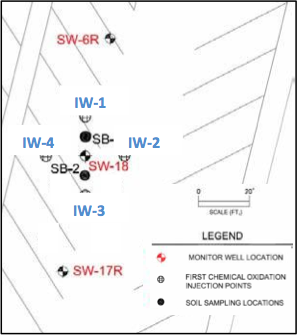
Pre-Injection Baseline Analytical:
On January 12, 2012, baseline groundwater samples from monitoring wells SW-6R, -17R, and 18 (Figure 1) were collected for BTEX (benzene, toluene, ethylbenzene, xylene) and TRPH (total recoverable petroleum hydrocarbons) analysis (Figure 3, 4). On January 13, 2012, two soil borings (SB-1 and SB-2) were completed and baseline soil samples were collected from 12-14 feet below land surface for BTEX analysis (Figure 2). Figure 2 shows the average soil BTEX concentration for SB-1 and SB-2 before and after PetroCleanze injection.
PetroCleanze Injection:
On February 2-3, 2012, a total of 2,220 gallons of 5% solution of PetroCleanze was injected into four injection points surrounding SW-18. Each point received a total of 550 gallons of solution, including 220 lbs of RegenOx Part A, 240 lbs of PetroCleanze, and 500 gallons of water. The biosparge system was reactivated for the duration of the treatment event.
Post-Injection Analytical:
On March 12, 2012 and July 10th, 2012, groundwater samples from groundwater monitor wells SW-6R, -17R, and -18 were collected for BTEX and TRPH analysis (Figure 3, 4). Also on March 13th and July 23rd, 2012, two soil borings (SB-1 and SB-2) were completed and soil samples were again collected for BTEX analysis (Figure 2).
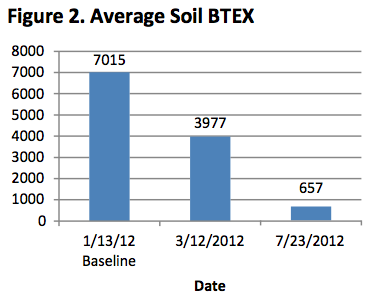
Results:
Performance parameters were evaluated for SW-6R, -17R, and -18 and a marked increase in ORP values was observed in each of the three wells following the PetroCleanze injection indicating chemical oxidation activity. Additionally, the pH in wells SW-17R and -18 increased significantly, providing evidence that alkaline conditions resulted from the application of PetroCleanze. As anticipated, increases in TRPH and BTEX concentrations in the sampled wells were observed following PetroCleanze injection as compared to baseline (Figure 3, 4). SW-17R was slightly unique in that BTEX concentrations went down. When looking at the average soil BTEX concentration of the two soil samples (Figure 2) in January, March, and July 2012 (7,015, 3,977, and 657 μg/kg, respectively) there was a 43% reduction between January and March and a 91% reduction between January and July 2012 after continued biosparging treatment.


Conclusion and Recommendations:
The PetroCleanze application was successful and the material easily applied. Performance exceeded expectations as only one injection was needed to strip 91% of the BTEX contamination from the soil into the dissolved phase. The reactivated biosparge system was able to treat the increased dissolved phase contaminants in the treatment area.
The current groundwater concentrations at the site are very low in key monitoring wells; therefore, the project does not require additional treatment at this time. However, should a change in contaminant concentration be observed at the site once active remediation has been ceased then additional treatment will be considered.
Combined Remediation Approach – Dual Phase Vacuum Extraction with In Situ Chemical Oxidation
Introduction
When redevelopment of an old service station was proposed, site investigations revealed a significant petroleum hydrocarbon impact within the soil and groundwater. The subsurface contamination threatened to derail the redevelopment program and a rapid remediation strategy was needed to reduce concentrations to acceptable levels. Geo2 Remediation was contacted to remediate the site in order to allow safe development for luxury residential properties while ensuring no impact to local protected controlled waters.

Figure 1. Successful Site Remediation Leads to Luxury Residence Redevelopment
Project Background
Geo2 Remediation carried out the treatment of a former service station following historic leakage from underground storage tanks (USTs). The tanks had been removed prior to the beginning of the site investigation. Free product was discovered at the surface of the saturated zone and elevated concentrations of total petroleum hydrocarbons (TPH) were observed within the groundwater. Concentrations of TPH as high as 290 mg/L were discovered within the source area.
In Situ Physical Remediation
Geo2 Remediation installed a dual phase vacuum extraction (DPVE) system, designed to rapidly remove phase separated product identified on the surface of the groundwater. The DPVE system began treatment in September 2007. Thicknesses of free product up to 50mm, identified around the former tank farm, were removed within 1 month of commencing treatment. Within the groundwater, TPH concentrations were reduced to between 300 mg/L and 150 mg/L over a 5-month monitoring period. In order to increase the efficiency of the DPVE system, Geo2 augmented the physical treatment system with RegenOx to provide a rapid reduction in soil and groundwater concentrations and allow redevelopment to proceed on schedule.
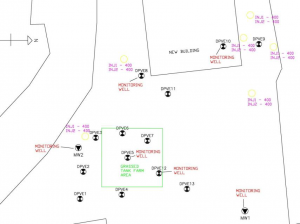
Combined In Situ Physical Remediation and Chemical Oxidation
Geo2 Remediation applied RegenOxTM, a safe and easy to apply proprietary in situ chemical oxidation (ISCO) designed to provide rapid concentration reduction of contaminants without a violent exothermic reaction or other handling difficulties common to ISCO reagents. RegenOx was injected into the subsurface around the dissolved phase impact following DPVE system shutdown using a direct-push injection rig. Two applications were completed within one week of each other using a modest dose of 326 kg RegenOx to achieve sorbed-phase desorption and partial chemical oxidation of the residual hydrocabons. The DPVE system was then restarted to remove the resulting desorbed contamination and partially oxidised hydrocarbon species from the groundwater – this enabled the Reagent requirements to be kept to a minimum (i.e. partial contaminant oxidation rather than full contaminant oxidation) whilst capitalising on the use of the DPVE system already in place. The total cost of the RegenOx application – including all fieldwork – was approximately £ 5,000, the cost of one month’s DPVE operation at the site.
RegenOx® Basics
RegenOx® is a proprietary two-part chemical oxidation product developed and sold by Regenesis for in situ groundwater treatment. It combines the use of a controlled-release percarbonate-based oxygen compound with a proprietary multi-part catalyst to generate surface-mediated free-radical generation and contaminant oxidation (e.g. perhydroxyl radical, hydroxyl radical and superoxide radical), with reactive power comparable to that of Fenton’s reagent but with greatly facilitated handling and subsurface delivery / longevity (up to 30 days). This provides an effective contaminant oxidation reaction without violent exothermic reaction, and can therefore be handled using a wide range of standard field equipment (e.g. direct push injection rigs) or applied directly to excavations. Furthermore, it is alkaline and can therefore be used in calcareous formations in addition to sands and gravels etc.
RegenOx-enhanced Contaminant Desorption
RegenOx has been designed as a bespoke remediation product to provide advantages in usage and application over commodity chemical products used for ISCO (e.g. permanganates, persulphates, peroxides). One of the design features it includes is reduced losses onto the aquifer matrix, commonly known as the matrix Natural Oxidant Demand (NOD). This is achieved by RegenOx through a powerful desorption / surfactant effect of the combined product (principally the catalyst) that draws the contaminant off the soil surface and into solution / onto the catalytic surface where localised free-radical generation occurs leading to focused contaminant destruction. This restricts the oxidant losses onto tightly bound and heavier soil organics such as humics, roots, and other natural or immobile fractions. At the same time, RegenOx is purely inorganic therefore adding no organic surfactant to the system that may prevent a competitive oxygen sink to on-going contaminant biodegradation.
The present project makes use of this product feature to combine in situ chemical oxidation with enhanced physical mass recovery. RegenOx-desorbed contaminant mass and partially oxidised (more soluble) organic species are recovered via groundwater abstraction using the DPVE system, whilst further contamination is destroyed in situ by oxidation.
Results
Upon completing the RegenOx applications, desorption from the highly impacted soils produced a temporary increase in groundwater hydrocarbon concentrations to a maximum of 4,800 mg/L. One week after the second application was completed, the DPVE system was re-started, rapidly reducing the TPH concentrations in the groundwater to an average of 20 mg/L. The improved efficacy of the DPVE system can be seen in Graph 1 where the linear trendline of MW-2 before and after the RegenOx applications shows a conservative 80% reduction in contaminant concentrations within two months – effectively increasing the DPVE efficiency by more than 500% at this stage in its operation. Once the DPVE system was switched off, further monitoring showed that there was no rebound in groundwater hydrocarbon concentrations due to the augmentation process successfully reducing the sorbed TPH concentrations of the soils.
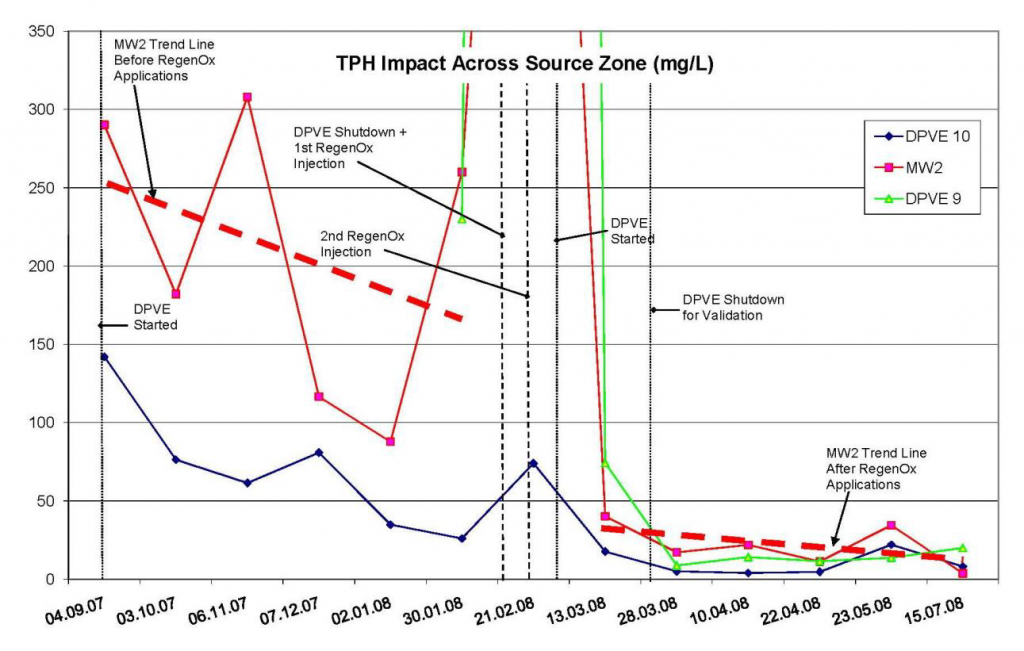
RegenOx Treats #2 Fuel Oil Plume Beneath Residential Home
CASE SUMMARY
Home Heating Oil, New Jersey
A 550-gallon leaking underground storage tank (UST) containing #2 fuel oil was removed from a single family residence in New Jersey (Figure 1). In addition, the surrounding soil was excavated and sampling was performed to determine the extent of the petroleum hydrocarbon plume within soil and groundwater. The plume was delineated at approximately 1,800 ft2 with
concentrations of total petroleum hydrocarbons as high as 40,000 parts per million (ppm) in soil and approximately 40,000 parts per billion (ppb) in groundwater. An estimated 20% of the plume was determined to be located beneath the home itself, eliminating the option for extensive soil excavation. Other remedial strategies such as pump & treat, monitored natural attenuation, and enhanced fluid recovery were ruled out as they did not provide a timely, cost-effective solution.
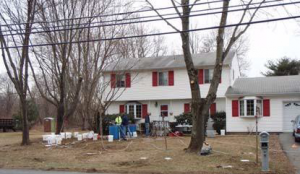
Figure 1. Residential Site
- Soil Type: Fine to Medium Sands
- Treatment Thickness: 5 to 12 feet bgs
- Free Product: 1” to 3” observed
- Contaminants of Concern:
- TPH – Total Petroleum Hydrocarbons
- TVOC – Total Volatile Organic Carbon
- TSVOC – Total Semi-Volatile Organic Carbon
| Contaminant | Concentration |
| TPH – soil | 40,000 ppm |
| TVOC – gw | 7,900 ppb |
| TSVOC – gw | 40,000 ppb |
REMEDIATION TECHNOLOGY
In Situ chemical oxidation (ISCO) using RegenOxTM was chosen as the most appropriate technology to treat the soil and groundwater plume. In addition, an application of a slow-release oxygen compound, ORC Advanced®, was applied following RegenOx to stimulate aerobic biodegradation of any residual contaminants. RegenOx was applied based on the following:
- Least disruptive to the homeowner
- Successful track record
- Feasible site conditions – sandy soils and a shallow water table paired well with direct-push injection
- Low natural organic carbon in saturated zone
- Safe to use and easy to apply
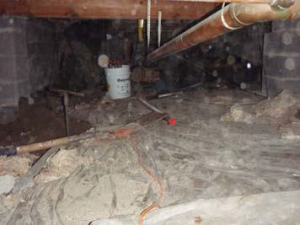
Ten permanent injection points were installed around the source area, at the edge of the plume and beneath the house in the crawl space as seen in Figure 2. During the installation, free phase product was observed in monitoring wells at approximately 1 to 3 inches. The NJDEP’s Permit-by- Rule prohibited the injection of any remediation technology should free product be present. Once the removal was complete, RegenOx could be applied as designed.
CONTAMINANT PLUME TREATMENT
Free Product Removal
The free product was removed using a mild surfactant and a high powered vacuum extraction truck within the source area. This process also effectively distributed the surfactant across the impacted zone for further desorption of contaminants from the soil matrix. Three free product recovery events were performed which effectively removed all free product from the wells and surrounding areas. TVOC concentrations in groundwater dropped only slightly as a result of the free product removal. However, concentrations of TSVOCs more than doubled in groundwater as a result of desorption from soil.
ISCO Injection for TPH Reduction
The application design included two RegenOx injection events and a third combined RegenOx and ORC Advanced injection for on-going biostimulation to treat residual contaminants. Using temporary and permanent injection points, a total of 6,210 pounds of RegenOx was applied from 5 to 11 feet bgs. The third injection included 650 pounds of ORC Advanced.
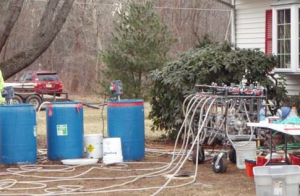
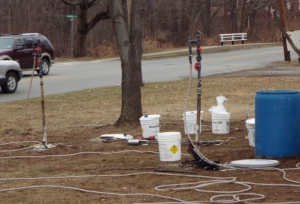
Conclusion
No free product, sheen or film was observed after the injections were completed (Figure 5). Levels of dissolved oxygen 30 days following the final application were measured at approximately 10-20 ppm indicating the presence of ORC Advanced in the subsurface.
Within 6 months, significant reductions in petroleum hydrocarbons were observed. TVOCs declined from 7,900 to <50 ppb and TSVOCs were reduced from 40,000 to <150 ppb. Further Action status from the NJDEP. The site is currently seeking No Further Action status from the NJDEP.
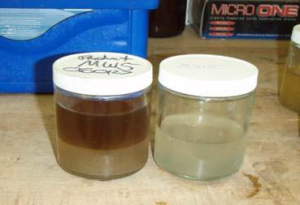
Combined Technologies Replace Pump and Treat System
Manufacturing Facility Remediated Using Bioremediation, Bioaugmentation and ISCR
Project Highlights
- Combined technologies of bioremediation and ISCR were used to treat the PCE
- The remediation design replaced a costly legacy pump and treat system
- More than $200,000 per year saved by shuting down pump and treat system
- RRS’ injection strategy allows for the coapplication of BDI Plus, 3D-Microemulsion and CRS during the same mobilization event
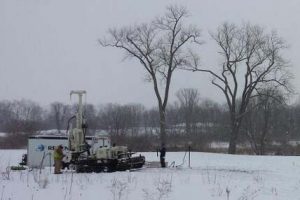
Project Summary
Historic activities at an active manufacturing facility contaminated a sand aquifer with chlorinated solvents (primarily perchloroethene, PCE). Previous remediation activities included an extensive pump and treat system as well as other in situ activities. The cost of operating the pump and treat system was such that the client looked for a more cost-eff ective remediation approach. Regenesis Remediation Services (RRS) combined bioremediation/in situ chemical reduction (ISCR) approach proved to be cost-effective as a replacement technology for the pump and treat system, saving the client more than $200,000 per year. This remediation solution was installed both inside and outside of the manufacturing facility during winter in sub-zero temperatures.
Remediation Approach
Four treatment rows of a total 48 injection points were used to apply the product with a treatment area of 5-30 feet below ground surface.
The following in situ remediation technologies were used:
- 19,300 pounds of 3-D Microemulsion FE®
- 48 liters of Bio-Dechlor INOCULUM Plus®
- 2,400 pounds of Chemical Reducing Solution (CRS®)
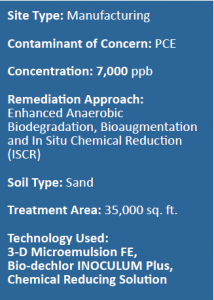
Technology Description
3-D Microemulsion FE is an engineered electron donor material that off ers a novel 3-stage electron donor release profi le, pH neutral chemistry and is delivered on-site as a factory-emulsifi ed product. When injected into the subsurface, this stimulates bioremediation of the pollutant by the process of biologically enhanced reductive dechlorination. Bio-Dechlor INOCULUM Plus is an enriched natural microbial consortium containing a high density of Dehalococcoides sp. (DHC). This microbial consortium, when added to the subsurface augments the naturally occurring population of microbes that carry out the desired reductive dechlorination process. CRS (Chemical Reducing Solution) is a soluble iron substrate designed to easily distribute to an aquifer and stimulate that serves to stimulate the abiotic in situ chemical reduction (ISCR) of halogenated hydrocarbon contaminants.
Chlorinated Solvent Concentrations Reduced >100x within Six Months
Enhanced Reductive Dechlorination Used to Treat Former Dry Cleaner in South Carolina Coastal Plain
Project Highlights
- Small groundwater recovery system in place to provide hydraulic control.
- Enhanced Reductive Dechlorination (ERD) treatment selected to achieve site closure more quickly.
- High PCE concentrations reduced by more than 100x within 6 months and remain <5 ug/L two years post-injection.
- Follow-up treatments enhanced initial injection and contributed to continued dechlorination.
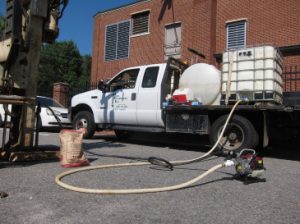
Project Summary
The site, located in the Coastal Plain of South Carolina, was impacted from former dry cleaning operations. A small groundwater recovery system had historically been used to provide hydraulic control, but the site owner wanted to move the site toward closure more quickly. Enhanced Reductive Dechlorination (ERD) with 3-D Microemulsion® was selected based on cost, ease-of-use and expected remediation performance. After the initial injection, PCE concentrations decreased by more than 100x within 6 months of application and remain below 5 ug/L two years after the initial injection.
Remediation Approach
The core of the plume was characterized by concentrations of 14-18 mg/L PCE at baseline plus the full suite of chlorinated ethene daughter products. An initial application of 3-D Microemulsion occurred in June 2011 over a 7,750-square-foot area in the surficial aquifer from 3-25 feet below ground surface. The injections were completed using direct-push equipment into temporary borings on 13-20 foot centers. Based on the success of the initial injection, a follow-up injection was completed in September 2013 over a much smaller footprint (2,200 square feet) to fill in treatment gaps near the upgradient edge of the initial treatment area and to supplement the 3-D Microemulsion in the core of the plume. The follow-up treatment has built on the initial treatment and is contributing to continued depletion of the chlorinated solvents.
Technology Description
3-D Microemulsion is an engineered electron donor material that offers a novel 3-stage electron donor release profile, pH neutral chemistry and is delivered on-site as a factory-emulsified product.
Turn-Key PCE Plume Remediation on at Michigan Superfund Site
Former Manufacturing Facility Treated with 437,000 Pounds of PersulfOx® in 18 Days
Project Highlights
- PersulfOx was selected over other persulfate activation methods because of its inherent health and safety benefits and easy-of-use.
- An aggressive application schedule was implemented to satisfy stakeholders – 37,800 lbs (15,500 gallons) of PersulfOx were injected in a single day.
- On-site diagnostics conducted by RRS confirmed PersulfOx distribution throughout the targeted treatment area.
- The project was completed ahead of schedule and on budget.
- The site was left with minimal impact to the PGA Championship Golf Course.
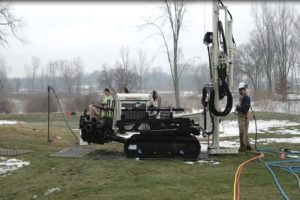
Project Summary
A former manufacturing facility in Western Michigan was redeveloped into an active golf course. The USEPA took over responsibility for cleanup of the chlorinated solvents that remained. Regenesis Remediation Services (RRS) was contracted by a leading consulting fi rm to implement a remediation design to address the chlorinated VOC plume with concentrations as high as 3,000 ppb. PersulfOx was selected over other persulfate activation methods such as hydrogen peroxide or alkaline activate on because the built-in catalyst minimized hazardous materials handling allowing for a safer and easier application. This was especially important because of the treatment areas close proximity to a sensitive receptor (river). Despite persistent freezing temperatures, RRS was able to finish this project ahead of the projected schedule. The RRS team faced a unique challenge on this site as it is a PGA Championship Golf Course which required extreme caution while injecting on the course. Strategic injection point placement, equipment staging, and surface protection via mats were just a few of the techniques implemented by the team
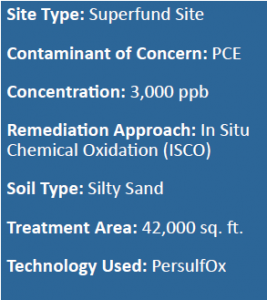
Remediation Approach
The 18-day injection event included 437,000 pounds of PersulfOx which was applied through 129 injection points in a grid pattern 5-30 feet below ground surface. The team used two direct-push injection machines to apply PersulfOx into eight points injection simultaneously.
Technology Description
PersulfOx is a sodium persulfate-based chemical oxidation technology which destroys both hydrocarbon and chlorinated solvent-type contaminants in the subsurface. PersulfOx contains a built-in catalyst which activates the persulfate componentand generates contaminant-destroying free radicals without the need for the addition of a separate activator.
Barrier Design and Angled Injections used to Treat BTEX and MTBE to Non-Detect
Project Highlights
- A former service station was contaminated with BTEX and MTBE.
- Enhanced aerobic biodegradation using ORC Advanced was used for treatment.
- The remediation design utilized a staggered, barrier configuration to optimize oxygen distribution.
- Angled injections were used to deliver ORC Advanced beneath the restaurant.

Summary
A former gasoline service station in Colorado had three petroleum underground storage tanks
(USTs) and associated product dispensers/lines removed in 2009. Subsequent site investigation activities delineated the majority of soil and groundwater contamination, identified LNAPL and groundwater impacts as high as 7.45 mg/L for benzene and 21.9 mg/L for MTBE. A soil vapor extraction well and numerous enhanced fluid recovery (EFR) events were performed between January 2001 and November 2011 to remove LNAPL.
LNAPL levels were removed and injection technologies were evaluated to polish the remaining groundwater plume.Because the site had been converted to a busy restaurant it was imperative the selected technology allow for relatively quick injections and mitigate potential surfacing with would cause unwanted aesthetic and health and safety concerns. After evaluating several other enhanced bioremediation options ORC® Advanced was selected for direct-push injection at the site.
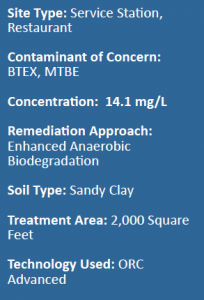
Remediation Approach
A series of enhanced biodegradation treatment barriers were placed along the length of the plume source and staggered to optimize oxygen distribution through the aquifer. Angled injections were required to place 24 points of ORC Advanced in multiple treatment rows beneath the restaurant and drive-through lanes. Since depth to groundwater was roughly 28-feet below ground surface this aided in the ability to angle inject product to all required locations beneath the restaurant property. Approximately 1,200 pounds of ORC Advanced was injected on-site.
Post ORC Advanced application, the monitoring well beneath the restaurant and directly below the former tank excavation has measured below detection limits for four quarters. Another well located just below the former east end of the tank excavation was below detection limits for the previous three quarters starting with the first quarter after injection. Although groundwater treatment in the main plume has proven to be effective, additional LNAPL was since identified at wells farther east of the restaurant and of the former tank excavation. This unexpected discovery of LNAPL post-treatment may undergo additional EFR and potential ORC Advanced application.
Technology Description
Advanced Formula Oxygen Release Compound (ORC Advanced®) is a proprietary formulation of food-grade, calcium oxy-hydroxide that produces a controlled-release of molecular oxygen for periods of up to 12 months upon hydration.
Test Project Italiano
Lorem ipsum dolor sit amet, consectetur adipiscing elit.Read More

 Americas
Americas Europe
Europe Français
Français Deutsch
Deutsch Italiano
Italiano Español
Español

